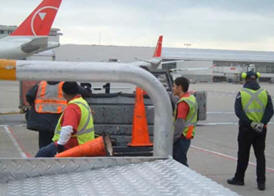|
|||||||||||
|
|
|
|||
|
By |
||||
 |
This is the 26th consecutive decrease in full-time equivalent employee (FTE) levels for the scheduled passenger carriers from the same month of the previous year. FTE calculations count two part-time employees as one full-time employee. BTS, a part of the Research and Innovative Technology Administration, reported that the August FTE total of 377,835 for the scheduled passenger carriers was 6,469 below that of August 2009. Historic employment data can be found on the BTS web site. |
|||
|
|
||||
|
Five network airlines decreased employment from August 2009 to August 2010. The sixth network carrier, Delta Air Lines, after completing its merger with Northwest Airlines, is reporting combined employment numbers in 2010 and reported 6.2 percent more FTEs in August 2010 than the combined totals of both carriers for August 2009. Network airlines operate a significant portion of their flights using at least one hub where connections are made for flights to down-line destinations or spoke cities. AirTran Airways was the only low-cost carrier to report a decrease in employees from August 2009. Six low-cost carriers reported an increase in employment. Regional carriers Comair, Horizon Air, Mesa Airlines, Air Wisconsin Airlines, Mesaba Airlines, Shuttle America Airlines, and Lynx Airlines also reported reduced employment levels compared to last year. Scheduled passenger airline categories include network, low-cost, regional and other airlines. The six network airlines employed 256,122 FTEs in August, 67.8 percent of the passenger airline total, while seven low-cost carriers employed 16.9 percent and 18 regional carriers employed 13.8 percent. Low-cost airline FTEs were up 2.0 percent in August 2010 from August 2009. Low-cost airlines are those that the industry recognizes as operating under a low-cost business model, with lower infrastructure and aircraft operating costs. |
||||
|
Six low-cost
airlines reported year-to-year increases: Virgin America Airlines, 12.7
percent; Frontier Airlines 11.8 percent; Spirit Airlines, 8.7 percent;
Allegiant Air, 8.4 percent; JetBlue Airways, 2.1 percent; and Southwest,
0.3 percent. AirTran
reported a year-to-year FTE decrease. Regional airline FTEs were down 7.2 percent in August 2010 compared to August 2009, the 24th consecutive month with a decline from the same month of the previous year. Comair, down 52.0 percent, and Lynx, down 46.6 percent, reported the largest decreases in the regional group. Republic Airlines, up 23.8 percent; and Compass Airlines, up 14.5 percent, reported the largest increases in the group.
Regional carrier
FTEs declined 8.8 percent from August 2006 to August 2010. The 15
regional carriers reporting employment data in both 2006 and 2010
employed 11.4 percent fewer FTEs in 2010 than in 2006. Comair reported
the largest percentage decline, down 57.5 percent, followed by
Republic reported
the biggest four-year gain, 239.2 percent, followed by GoJet at 70.2
percent. Effective with October 2009 reporting, Republic's employment
numbers include FTE's from Midwest Airlines.
Regional carriers
typically provide service from small cities, using primarily regional
jets to support the network carriers' hub and spoke systems. Airlines
that operate at least one aircraft with the capacity to carry combined
passengers, cargo and fuel of 18,000 pounds – the payload factor – must
report monthly employment statistics. The Other Carrier category
generally reflects those airlines that operate within specific niche
markets, such as Continental Micronesia in the Southwest Pacific and
Hawaiian Airlines serving the
|
||||||||||||||||||||||||||||||||||||||||||||||||||||||||||||||||||||||||||||||||||||||||||||||||
| Other News Stories |
||||||||||||||||||||||||||||||||||||||||||||||||||||||||||||||||||||||||||||||||||||||||||||||||
| ©AvStop
Online Magazine
Contact
Us
Return To News
|
||||||||||||||||||||||||||||||||||||||||||||||||||||||||||||||||||||||||||||||||||||||||||||||||
|
||||||||||||||||||||||||||||||||||||||||||||||||||||||||||||||||||||||||||||||||||||||||||||||||


